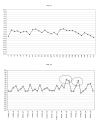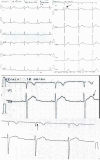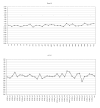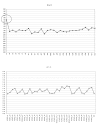The electrocardiographic abnormalities in highly trained athletes compared to the genetic study related to causes of unexpected sudden cardiac death
- PMID: 20108749
- PMCID: PMC3019018
The electrocardiographic abnormalities in highly trained athletes compared to the genetic study related to causes of unexpected sudden cardiac death
Abstract
Background: Electrocardiograms in elite endurance athletes sometimes show bizarre patterns suggestive of inherited channelopathies (Brugada syndrome, long QTc, catecholaminergic polymorphic ventricular tachycardia) and cardiomyopathies (arrhythmogenic right ventricular cardiomyopathy, hypertrophic cardiomyopathy) responsible for unexpected sudden cardiac death. Among other methods, genetic analyses are required for correct diagnosis.
Objective: To correlate 12-lead electrocardiographic patterns suggestive of inherited channelopathies and cardiomyopathies to specific genetic analyses.
Design: Prospective study (2004-2007) of screening 12-lead ECG tracings in standard position and higher intercostal spaces V1 to V3 precordial leads, performed in athletes and normal sedentary subjects aged match. Genetic analyses of subjects with ECG abnormalities suggested inherited channelopathies and cardiomyopathies.
Setting: All cardiologic exams and electrocardiograms were performed at "Prof. Dr. C.C. Iliescu" National Institute of Cardiovascular Diseases (Bucharest, Romania). The genetic studies were done at "Mina Minovici" National Institute of Forensic Medicine (Bucharest, Romania).
Participants: 347 elite endurance athletes (seniors--190, juniors--157), mean age of 20; 200 subjects mean age of 21, belonging to the control group of 505 normal sedentary population.
Results: Seniors. RSR' (V1 to V3) pattern, in 45 cases (23.68%), 5 of them with questionable Brugada sign (elevated J wave and "coved" ST segment, < 2 mm in one lead, V1. Typically, Brugada 1 sign was found in one case (0.52%) with no SCN5A abnormalities. One athlete (0.52%) had normal ECG and exon1 SCN5A duplication. MRI confirmed three arrhythmic right ventricular cardiomypathy epsilon waves (1.57%), in one case. ST-segment elevation myocardial injury like in V1-V3 precordial leads in 34 athletes (17.89%). Genetic analyses-no gene mutations. Juniors. Upright J wave was found in 43 cases (27.38%). Convex ST segment elevation in V1-V3/V4, in 39 cases (24.84%). Bifid T wave with two distinct peaks was found in 39 cases (24.84%), 5 of them with mild prolonged QTc (0.48"-0.56") and KCN genes mutations. Nine (5.73%) of the elevated ST segment juniors had questionable Brugada sign, two of which with KCN (n=1) and SCN5A (n=1) gene mutations. Ajmaline provocative test was negative in 4 and was refused by 5 subjects.
Conclusion: Bizarre QRS, ST-T patterns suggestive of abnormal impulse conduction in the right ventricle, including the right outflow tract, associated with prolonged QTc interval in some cases were observed in highly trained endurance athletes. The genetic analyses, negative in most athletes, identified surprising mutations in SCN5A and KCN genes in some cases.
Figures







Similar articles
-
[Doubts of the cardiologist regarding an electrocardiogram presenting QRS V1-V2 complexes with positive terminal wave and ST segment elevation. Consensus Conference promoted by the Italian Cardiology Society].G Ital Cardiol (Rome). 2010 Nov;11(11 Suppl 2):3S-22S. G Ital Cardiol (Rome). 2010. PMID: 21361048 Italian.
-
Electrocardiographic features of inherited diseases that predispose to the development of cardiac arrhythmias, long QT syndrome, arrhythmogenic right ventricular cardiomyopathy/dysplasia, and Brugada syndrome.J Electrocardiol. 2000;33 Suppl:1-10. doi: 10.1054/jelc.2000.20360. J Electrocardiol. 2000. PMID: 11265707 Review.
-
[Sudden cardiac death in athletes with an apparently normal heart: the channelopathies].G Ital Cardiol (Rome). 2008 Oct;9(10 Suppl 1):78S-82S. G Ital Cardiol (Rome). 2008. PMID: 19195312 Italian.
-
Brugada syndrome in children.Expert Rev Cardiovasc Ther. 2015 Feb;13(2):173-81. doi: 10.1586/14779072.2015.999765. Epub 2015 Jan 13. Expert Rev Cardiovasc Ther. 2015. PMID: 25583159 Review.
-
Insights into the location of type I ECG in patients with Brugada syndrome: correlation of ECG and cardiovascular magnetic resonance imaging.Heart Rhythm. 2012 Mar;9(3):414-21. doi: 10.1016/j.hrthm.2011.10.032. Epub 2011 Nov 23. Heart Rhythm. 2012. PMID: 22119454
Cited by
-
Epsilon wave: A review of historical aspects.Indian Pacing Electrophysiol J. 2019 Mar-Apr;19(2):63-67. doi: 10.1016/j.ipej.2019.02.003. Epub 2019 Feb 21. Indian Pacing Electrophysiol J. 2019. PMID: 30796961 Free PMC article. Review.
-
Evaluation of Dietary Intakes, Body Composition, and Cardiometabolic Parameters in Adolescent Team Sports Elite Athletes: A Cross-sectional Study.Adv Biomed Res. 2017 Aug 28;6:107. doi: 10.4103/2277-9175.213667. eCollection 2017. Adv Biomed Res. 2017. PMID: 28904935 Free PMC article.
-
The Hidden Fragility in the Heart of the Athletes: A Review of Genetic Biomarkers.Int J Mol Sci. 2020 Sep 12;21(18):6682. doi: 10.3390/ijms21186682. Int J Mol Sci. 2020. PMID: 32932687 Free PMC article. Review.
-
Heart Rate-Corrected QT and JT Intervals in Electrocardiograms in Physically Fit Students and Student Athletes.Ann Noninvasive Electrocardiol. 2016 Nov;21(6):595-603. doi: 10.1111/anec.12374. Epub 2016 May 19. Ann Noninvasive Electrocardiol. 2016. PMID: 27194642 Free PMC article.
References
-
- Maron BJ, Thompson PD, Ackerman MJ. Recommendations and considerations related to pre–participation screening for cardiovascular abnormalities in competitive athletes: 2007 update. A scientific statement from American Heart Association council on nutrition, physical activity and metabolism. American College of Cardiology Foundation. Circulation. 2007;115:1643–1655. - PubMed
-
- Pelliccia A. The pre–participation cardiovascular screening of competitive athletes: is it time to change the customary clinical practice? Eur Heart J. 2007;28:2703–2705. - PubMed
-
- Corrado D, Pelliccia A, Bjornstad NH. Cardiovascular pre–participation screening of young competitive athletes for prevention of sudden death: proposal for a common European protocol consensus statement of the study group of sport cardiology of the Working Group of Cardiac Rehabilitation and Exercise Physiology and Working Group of Myocardial and Pericardial Disease of the European Society of Cardiology. Eur Heart J. 2005;26:516–524. - PubMed
-
- Maron BJ, Zipes DP. 36th Bethesda Conference: eligibility recommendations for competitive athletes with cardiovascular abnormalities. J Am Coll Cardiol. 2005;45:1313–1375. - PubMed
Publication types
MeSH terms
LinkOut - more resources
Full Text Sources
Medical
Miscellaneous
